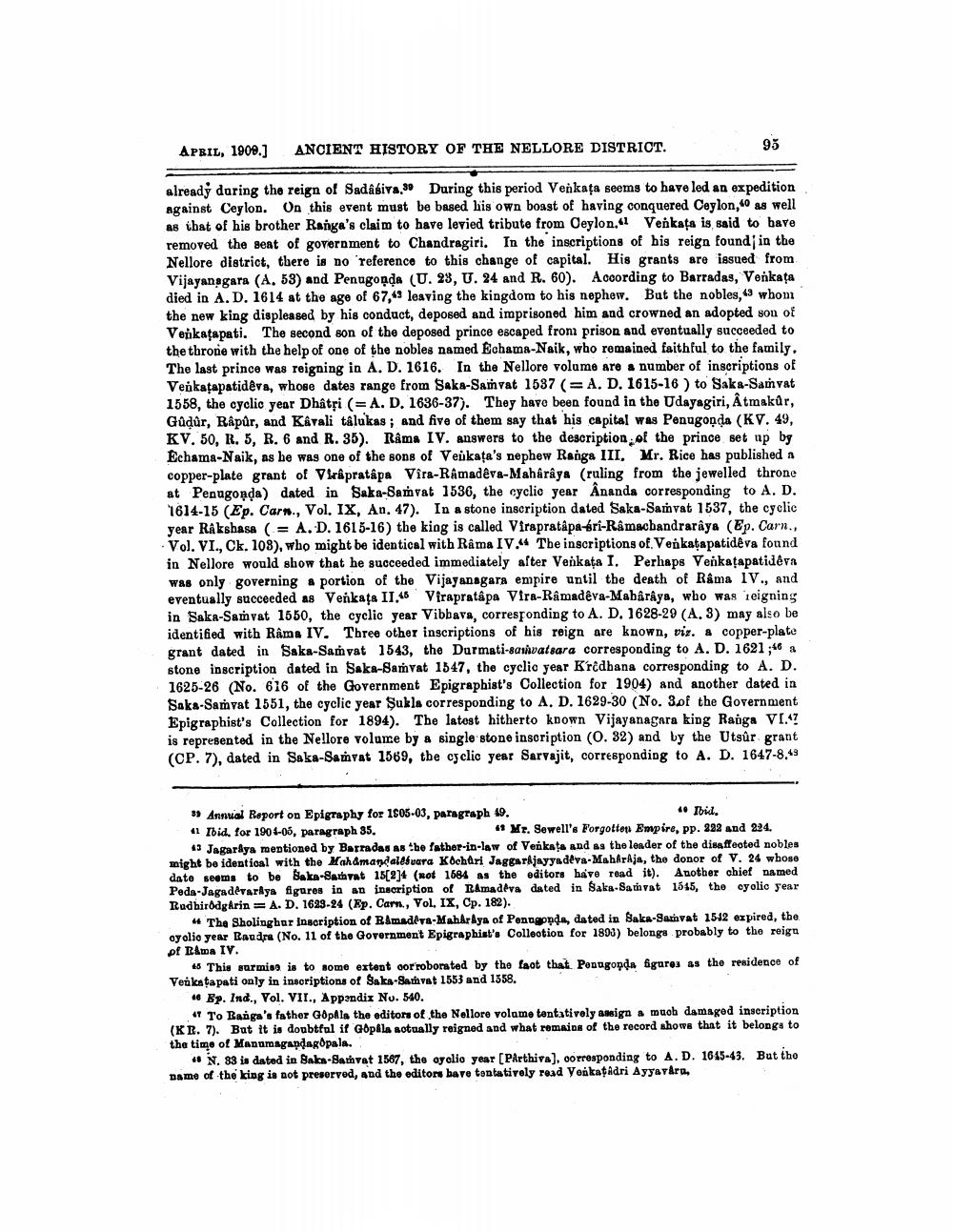________________
APRIL, 1900.)
ANCIENT HISTORY OF THE NELLORE DISTRICT.
95
already during the reign of Sadasiva,30 During this period Venkata seems to have led an expedition against Ceylon. On this event must be based his own boast of having conquered Ceylon, as well as ibat of his brother Ranga's claim to have levied tribute from Ceylon. Venkata is said to have removed the seat of government to Chandragiri. In the inscriptions of his reign found in the Nellore district, there is no reference to this change of capital. His grants are issued from Vijayanagara (A. 53) and Penugonda (U. 28, U. 24 and R. 60). According to Barradas, Venkata died in A.D. 1614 at the age of 67, leaving the kingdom to his nephew. But the nobles," whom the new king displeased by his conduct, deposed and imprisoned him and crowned an adopted son of Venkatapati. The second son of the deposed prince escaped from prison and eventually succeeded to the throne with the help of one of the nobles named Echama-Naik, who remained faithful to the family. The last prince was reigning in A. D. 1616. In the Nellore volume are a number of inscriptions of Venkatapatidēva, whose dates range from Saka-Samvat 1587 (= A.D. 1615-16 ) to Saka-Samvat 1558, the cyclic year Dhâtsi (= A.D. 1636-37). They have been found in the Udayagiri, Atmakur, Güdür, Râpúr, and Kávali talukas; and five of them say that his capital was Penugonda (KV. 49, KV, 50, R. 5, R. 6 and R. 35). Râms IV. answers to the description of the prince set up by Echama-Naik, as he was one of the sons of Veukata's nephew Ranga III, Mr. Rice has published a copper-plate grant of Virâpratapa Vira-Ramadêva-Mahârâya (ruling from the jewelled throne at Penugonda) dated in Saka-Samvat 1536, the cyclio year Ânanda corresponding to A. D. 1614-15 (Ep. Carn., Vol. IX, An. 47). In a stone inscription dated Saka-Samvat 1537, the cyclic year Rakshasa (= A.D. 1615-16) the king is called Virapratapa-bri-Ramachandraraya (Ep. Carn., Vol. VI., Ck. 108), who might be identical with Râma IV.44 Tbe inscriptions of Venkatapatidêva found in Nellore would show that he succeeded immediately after Venkata I. Perhaps Venkatapatidéra was only governing « portion of the Vijayanagara empire until the death of Râma IV., and eventually succeeded as Venkata II.45 Virapratâpa Vira-Ramadêva-Mabaraya, who was reigning in Saka-Samvat 1550, the cyclic year Vibbava, corresponding to A. D. 1628-29 (A.3) may also be identified with Râms IV. Three other inscriptions of his reign are known, vix. a copper-plate grant dated in Saka-Samvat 1543, the Darmati-sasivatsara corresponding to A. D. 1621;46 a stone inscription dated in Saka-Samvat 1347, the cyclic year K'ridbana corresponding to A. D. 1625-26 (No. 616 of the Government Epigraphist's Collection for 1904) and another dated in Saka-Samvat 1551, the cyclic year Şukla corresponding to A. D. 1629-30 (No. 3.of the Government Epigraphist's Collection for 1894). The latest hitherto known Vijayanagara king Ranga VI.? is represented in the Nellore volume by a single stone inscription (0.32) and by the Utsûr grant (CP. 7), dated in Saka-Samvat 1569, the cyclic year Sarvajit, corresponding to A. D. 1647-8.49
» Annual Report on Epigraphy for 1505-03, paragraph 19.
** Ibid. 11 Ibid. for 1901-06, paragraph 35.
* Mr. Sowell's Forgotten Empire, pp. 222 and 224. 13 Jagar&ya mentioned by Barradas as the father-in-law of Venkata and as the leader of the disaffested nobles might be identical with the Mahamandalesvara Kochari Jaggarkjayyadeva-Maharaja, the donor of V. 24 wboso date seems to be Baka-Sathyat 15[2]4 (not 1684 as the editors have read it). Another chief named Peda-Jagadérariya figures in an inscription of Ramadeva dated in Saka-Samvat 1515, the cyolic year Radbirädgårin= A. D. 1629-24 (Ep. Carn., Vol. IX, Cp. 182).
4 The Sholinghar Inscription of Bdmadera-Mahårkya of Penngonde, dated in Baka-Samvat 1512 expired, the ayolio year Raudra (No. 11 of the Government Epigraphist's Colleotion for 1893) belongs probably to the reiga pf Rama IV.
45 This surming is to some extent corroborated by the fact that. Penugopda figures as the residence of Venkatapati only in inscriptions of Saka-Samvat 1553 and 1358.
46 Ep. Ind., Vol. VII., Appendix No. 540.
47 To Raiga's father GopAls the editor of the Nellore volame tentatively assign a muoh damaged inscription (KR. 7). But it is doubtful if Gopila actually reigned and what remains of the record shows that it belongs to the time of Man magandag pala.
** N. 83 in dated in Baka-Bathvat 1567, the oyalio year (Parthiva), corresponding to A.D. 1645-43. But tho Dame of the king is not presoryod, and the editors bare tentatively road VonkaçAdri Ayyavara




